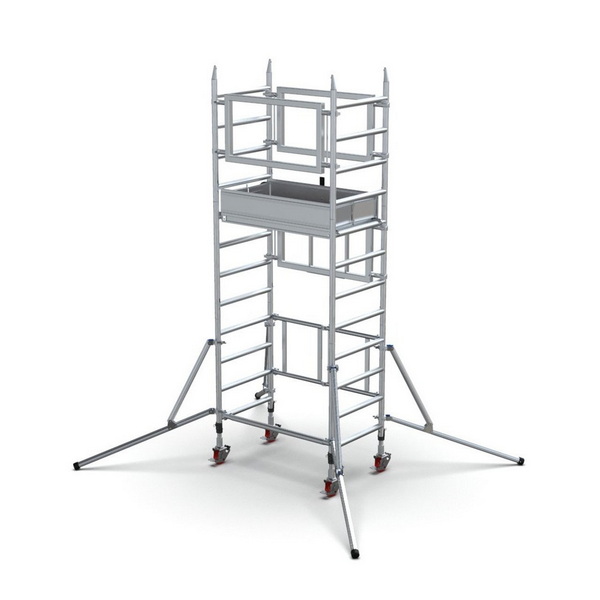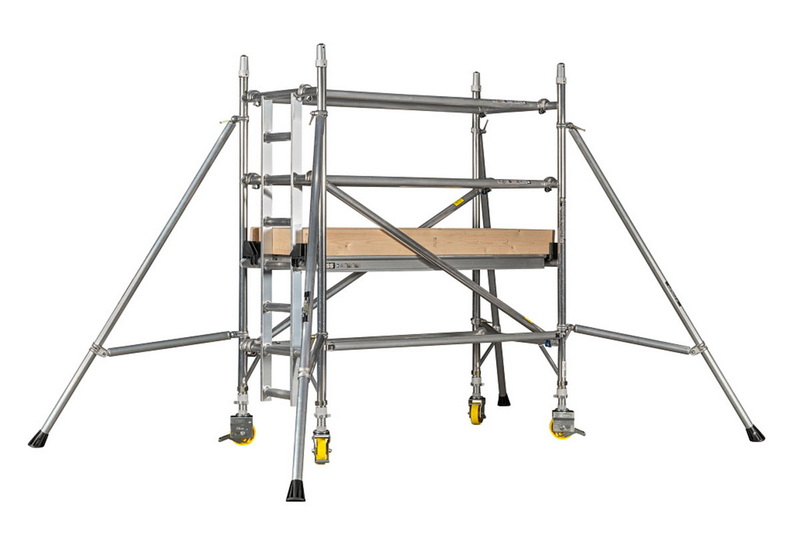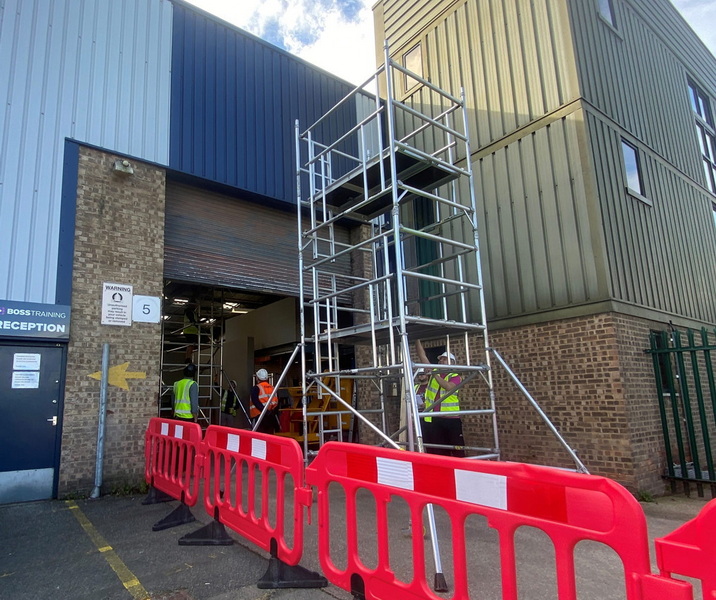Content Menu
● What Is a Mobile Scaffold Tower?
● Regulatory Standards Governing Mobile Scaffold Tower Height
>> OSHA (Occupational Safety and Health Administration) – USA
>> EN 1004 – Europe
>> AS/NZS 1576 – Australia/New Zealand
>> Summary
● Factors Affecting Maximum Height of Mobile Scaffold Towers
>> 1. Base Dimensions and Stability
>> 2. Material Quality and Construction
>> 3. Environmental Conditions
>> 4. Manufacturer Specifications
● Practical Height Limits for Different Uses
● Safety Considerations When Working at Height on Mobile Scaffold Towers
● Additional Design Features Influencing Height
>> Outriggers and Stabilizers
>> Locking Castors and Wheels
>> Platform Design and Load Capacity
● Common Mobile Scaffold Tower Types and Their Height Capacities
>> Aluminum Mobile Scaffold Towers
>> Steel Mobile Scaffold Towers
>> Modular Scaffold Towers
● Conclusion
● FAQ
>> 1. How high can a mobile scaffold tower go?
>> 2. What is the height-to-base width ratio for mobile scaffold towers?
>> 3. Can mobile scaffold towers be used outdoors at maximum height?
>> 4. Are outriggers necessary for taller mobile scaffold towers?
>> 5. What safety features are required on mobile scaffold towers?
Mobile scaffold towers are widely used in construction, maintenance, and industrial applications due to their portability, ease of assembly, and versatility. However, a critical question often arises: How high can a mobile scaffold tower go? This article provides a comprehensive and detailed answer, covering regulatory standards, safety considerations, design factors, and practical limits on the height of mobile scaffold towers.

What Is a Mobile Scaffold Tower?
A mobile scaffold tower is a freestanding scaffold structure mounted on wheels or castors, allowing it to be easily moved around a worksite. It typically consists of modular components such as frames, braces, platforms, and guardrails, which can be assembled to various heights depending on the task.
Regulatory Standards Governing Mobile Scaffold Tower Height
OSHA (Occupational Safety and Health Administration) – USA
- Height-to-Base Width Ratio: OSHA requires that mobile scaffold towers have a maximum height-to-base width ratio of 4:1 when stationary and 2:1 when being moved with workers on them.
- Use of Outriggers: Outriggers can be added to increase the base width, allowing for taller scaffold towers.
- Guardrails: Required at heights over 10 feet (3.05 meters).
- Movement Restrictions: Workers are generally prohibited from riding on moving mobile scaffolds unless specific safety requirements are met.
| Scaffold Base Width | Max Height (Stationary) | Max Height (While Moving with Workers) |
| 4 feet | 16 feet | 8 feet |
| 6 feet | 24 feet | 12 feet |
| 7 feet | 28 feet | 14 feet |
EN 1004 – Europe
- Maximum Height: 12 meters (39.4 feet) for internal use, 8 meters (26.2 feet) for external use without additional stabilizing measures.
- Modular Design: Towers are designed to be assembled safely up to these heights.
- Safety Features: Include guardrails, toe boards, and locking castors.
AS/NZS 1576 – Australia/New Zealand
- Maximum Height: 12 meters (39.4 feet) for mobile scaffolding.
- Safety Requirements: Similar to EN 1004 with requirements for stability and fall protection.
Summary
Most international standards set the maximum height of mobile scaffold towers between 8 meters (26 feet) and 12 meters (39 feet), depending on use conditions and safety measures.
Factors Affecting Maximum Height of Mobile Scaffold Towers
1. Base Dimensions and Stability
The height of a mobile scaffold tower is limited by its base dimensions to prevent tipping. Wider bases allow taller towers.
- Height-to-Base Ratios: Typically 4:1 for stationary towers without outriggers.
- Use of Outriggers: Extending the base width with outriggers increases allowable height.
2. Material Quality and Construction
- Frame Material: Aluminum frames are lightweight but strong, allowing taller towers.
- Bracing: Proper diagonal bracing increases rigidity and height capacity.
- Platform Strength: Platforms must support worker weight safely at height.
3. Environmental Conditions
- Wind Loads: High winds can destabilize tall towers, limiting height outdoors.
- Surface Conditions: Uneven or soft ground reduces stability.
4. Manufacturer Specifications
Each scaffold system is designed and tested for maximum safe height. Always follow manufacturer guidelines.

Practical Height Limits for Different Uses
| Application Type | Typical Max Height | Notes |
| Indoor Maintenance | Up to 12 meters | Controlled environment, less wind impact |
| Outdoor Construction | Up to 8 meters | Wind and weather limit height |
| Painting and Decorating | 6 to 10 meters | Often requires mobility and access |
| Industrial Facilities | Varies | May require custom scaffolds or lifts |
Safety Considerations When Working at Height on Mobile Scaffold Towers
- Guardrails and Toe Boards: Mandatory above 10 feet (3 meters).
- Fall Arrest Systems: May be required by local regulations.
- Inspection: Daily inspection of tower components.
- Training: Workers must be trained in scaffold safety.
- Movement: Do not move towers with workers on unless designed for it.
Additional Design Features Influencing Height
Outriggers and Stabilizers
Outriggers are extensions that widen the base footprint of the scaffold tower, significantly increasing stability and allowing for greater heights. Proper installation and use of outriggers are crucial when building towers above the standard height-to-base ratio limits.
Locking Castors and Wheels
High-quality locking castors prevent unwanted movement and increase safety when the tower is in use. Castors must be locked firmly before climbing or working on the tower.
Platform Design and Load Capacity
The platform must be strong enough to support workers and materials at height. Platforms with guardrails and non-slip surfaces enhance safety and usability.
Common Mobile Scaffold Tower Types and Their Height Capacities
Aluminum Mobile Scaffold Towers
Lightweight and corrosion-resistant, aluminum towers are popular for indoor use and can typically reach heights of up to 12 meters safely with proper bracing and outriggers.
Steel Mobile Scaffold Towers
Heavier but more robust, steel towers are often used outdoors and in industrial environments. Their maximum height is usually limited to 8 meters due to weight and wind load considerations.
Modular Scaffold Towers
These systems allow for customized height and configuration but must adhere to manufacturer and regulatory limits for safety.
Conclusion
The maximum height of a mobile scaffold tower depends on multiple factors including regulatory standards, base dimensions, material quality, environmental conditions, and manufacturer guidelines. While typical maximum heights range from 8 to 12 meters, safety must always be the priority. Proper assembly, use of outriggers, adherence to height-to-base ratios, and compliance with local regulations ensure that mobile scaffold towers provide safe and effective access solutions at height.

FAQ
1. How high can a mobile scaffold tower go?
Answer: Mobile scaffold towers can typically reach up to 12 meters (39.4 feet) indoors and 8 meters (26.2 feet) outdoors, depending on base width, use of outriggers, and manufacturer specifications.
2. What is the height-to-base width ratio for mobile scaffold towers?
Answer: OSHA requires a maximum 4:1 height-to-base width ratio when stationary and 2:1 when moving with workers on the tower.
3. Can mobile scaffold towers be used outdoors at maximum height?
Answer: Outdoor use is generally limited to 8 meters due to wind and stability concerns unless additional stabilizing measures are in place.
4. Are outriggers necessary for taller mobile scaffold towers?
Answer: Yes, outriggers increase the base width and allow for taller scaffold towers while maintaining stability.
5. What safety features are required on mobile scaffold towers?
Answer: Guardrails, toe boards, locking castors, and fall arrest systems are commonly required for towers over 10 feet (3 meters).






















